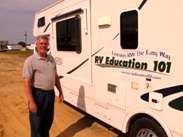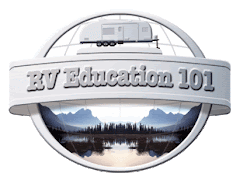I received an email from a reader the other day who was involved in a bad accident while towing a trailer 5 years ago. The accident was a result of a sudden wind shear, causing the trailer to start swaying out of control. The truck and trailer rolled over. Fortunately everybody was okay!
After detailing the accident, Mary who was driving at the time, asked me if I had any hints or tips to offer on trailer brakes, controlling sway, and what to do when you experience something like wind shear, cross winds, or towing in windy conditions. After reading Mary’s email I thought it would be an appropriate topic for an article.
Let me begin by saying that the safest measure for traveling by RV in windy conditions is not to travel at all. RV’s have a great deal of mass (length, width & height) and when that mass is confronted with strong wind gusts, crosswinds and/or wind shear the results can be devastating.
Sometimes the weather forecast can warn us that windy conditions are expected. These are the days that you need to make a conscious decision to stay put at the campground, or wherever you might be, and not take a chance traveling by RV. Trust me when I say it’s not worth the risk involved.
On the other hand what do you do when you are traveling on a fairly calm day and suddenly you are hit by a strong wind gust or crosswind? If you’ve been traveling by RV for awhile, either motorized or towable, you have probably experienced the forces of wind against the RV at one time or another. Possibly the most common occurrence is when a transfer truck passes you from the rear. I refer to this as the push, pull effect. The force of the air pressure coming off of the truck as it begins to pass pushes against the side of the RV and as it completes the pass it pulls you back in again. If you are not aware of the truck passing you, or if you are towing a trailer and don’t have some type of sway control this air pressure can cause the trailer to start swaying. The same dynamic occurs when a sudden wind gust hits the side of the RV unexpectedly.
The forces of air pressure are not the only thing that will cause a trailer to sway. Sway becomes an automatic factor with travel trailers simply because of how the trailer is hitched to the tow vehicle. The good news is that even though the potential for trailer sway is there, it can be controlled. Let’s look at some of the causes for trailer sway.
First and foremost poor trailer design contributes to trailer sway. When there is too much weight behind the trailers axles causing the tongue weight to be less than 10% of the trailers weight it has a natural tendency to sway.
*Incorrect tire inflation.
*Improper weight distribution hitch adjustments.
*No sway control on the trailer.
*Crosswinds
*A transfer truck passing from the rear of the trailer.
*Descending inclines
*Towing speeds and hitch weight
*Tow vehicle not properly matched for the trailer.
*Improper loading, overloading and poor weight distribution.
So, what can you do about it when it happens to you?
Most of these causes for trailer sway have quick and easy fixes. For starters, before you purchase a travel trailer, do your homework on the trailer. A poorly designed trailer will never handle well. Find a trailer with a tongue weight that is 10 to 15 percent of the trailers weight and match it with a tow vehicle that is capable of handling the load.
It is safe to say that with a well designed trailer, the proper tow vehicle, correct tire pressure, correct hitch adjustments, sway control and a properly loaded trailer we can control a great deal of potential trailer sway. That narrows the potential for sway down to what you could encounter at any given moment, even with a stable trailer; strong crosswinds, transfer trucks passing from the rear, bad driving conditions and descending steep inclines. Any one of these conditions will tend to push the trailer and tow vehicle sideways, but when equipped with the proper type of sway control and brakes, you can make normal steering corrections.
If the trailer become unstable and attempted steering corrections don’t control it you can use the manual override on the electronic brake control to regain control of the trailer. Slide the manual lever over slowly and allow the trailer brakes to engage and the sway control to put the trailer back on a straight course. If trailer sway becomes severe, reduce your speed gradually, avoid using the vehicle brakes if possible and manually apply more trailer brakes.
The brakes on the tow vehicle and trailer are a critical element to safe towing. Electric brake controllers are an essential component to safe trailer towing. The brake controller is installed inside the tow vehicle and supplies the power from the tow vehicle to the trailer’s electric brakes. There are two types of electric brake controllers, time delay activated and inertia activated. Time delay or solid-state controllers apply gradual voltage to the trailer brakes using a time delay circuit. A pendulum circuit that applies gradual voltage to the trailer’s brakes activates inertia or pendulum type controllers.
Both types of brake controllers allow you to adjust the amount of braking power and they both have manual overrides that can be used to activate the trailer brakes without using the vehicle brakes. The override feature can be used when descending an incline, to assist in slowing down and to prevent premature brake wear on the tow vehicle. It is also helpful in regaining control if the trailer begins to sway or fishtail. Always check the operation of the brake controller and trailer brakes before leaving on a trip.
*Have your trailer brakes, bearings and other components inspected at least once annually by a professional.
*Allow more distance for stopping then you are accustomed to. Do not follow other vehicles too closely.
*Do not use the tow vehicles brakes to control excessive trailer sway. This will usually make it worse. Manually apply the trailer brakes to regain control.
*When descending a steep incline, if it feels like the trailer is pushing the tow vehicle, reduce speed, down shift to a lower gear and use the manual override on the brake control to slow the trailer. Heavy use of the tow vehicle brakes can cause them to overheat and begin to fade.
*Always be prepared to slow down and try to avoid making sudden stops.
Passing Vehicles
*Allow more time for acceleration when planning to pass somebody. It may be necessary to shift out of overdrive for increased acceleration.
*Only attempt to pass a vehicle on a level road surface. Never attempt passing on steep upgrades or downgrades.
*When passing a vehicle or changing lanes, signal in advance and double check mirrors for oncoming traffic.
*When completing a pass, look in your mirror, if you can see both of the vehicles front tires on the road surface behind the trailer it is safe to signal and pull back in that lane.
*When passing, or being passed, anticipate the need to make steering corrections due to the air pressure created by other vehicles.
*Always be cautious of the road shoulder when passing. If the trailer gets on the shoulder it can jackknife or cause you to lose control.
Upgrades and Downgrades
Some vehicles have transmission tow modes. Consult your owner’s manual for the proper gears to use on your tow vehicle when towing a trailer.
*Downshift on downgrades to lessen the braking action required. Reduce your speed. Remember that trailer sway is more likely to occur when descending inclines.
*Downshift on upgrades for increased acceleration and power.
*On steep or long downgrades, reduce gears and avoid prolonged brake use on the tow vehicle. The brakes can easily overheat. Use the vehicle brakes in intervals.
*If the trailer becomes unstable when descending an incline and the trailer starts to sway, reduce your speed, avoid using the vehicle brakes, and manually activate the trailer brakes to regain control.
*On steep or long upgrades monitor all of the gauges on the tow vehicle instrument panel. If gauges do not read in the normal range, or the vehicle starts to overheat, pull over as soon as you safely can and call for help.
Safe Driving Tips
Some of these tips apply to pulling a trailer, some apply to driving a motorhome and some apply to both.
*Don’t speed. Driving at a moderate speed will put less stress and strain on the drive train components of your tow vehicle. It will also reduce the likelihood of the trailer becoming unstable and starting to sway.
*Monitor the gauges on the tow vehicle or motorhome instrument panel. If a gauge does not read in the normal range pull over as soon as it is safe, and call for help.
*Drive defensively! Stay alert and monitor what is going on around you at all times. Use your mirrors. For increased visibility, purchase some convex mirrors that you can apply on your side view mirrors. These mirrors are inexpensive and are available in auto parts stores. They come in different sizes and will improve your visibility a great deal, especially along the sides of the RV and in blind spots.
*If you’re pulling a trailer it may be necessary to add mirror extensions so you can see along the sides of the trailer. The mirrors on your tow vehicle can be your best friend when you’re towing a trailer. When you use your mirrors you will know when a transfer truck is passing, and you can anticipate the need for a slight steering correction when the trucks air pressure causes the trailer to move.
*Use the proper gear for driving conditions. If the transmission continues to shift in and out of overdrive you need to turn the overdrive off. Reducing gears can help to slow the trailer or motorhome down when descending inclines and give you the additional power you may need when ascending inclines.
Note: Read the tow vehicle owner’s manual for proper gear selection when towing.
*Try to avoid sudden stops. Stopping to quickly can cause a trailer to slide and possibly jackknife.
*Try to avoid quick, harsh steering movements if possible. This can cause a trailer to become unstable and increase the possibility of trailer sway.
*Slow down on loose road surfaces, such as gravel, and when the roads are slippery and wet.
*When towing a trailer or a vehicle behind a motorhome you need to make wider turns than you are accustomed to. Remember the pivot point for the trailer is its axles. Watch for tail swing and exercise caution when turning on narrow streets and maneuvering around fuel stations.
*When maneuvering around the campground, watch for tail swing, low branches and utility hook ups.
Happy Camping,
Mark Polk
RV Education 101
RV University
copyright 2009 by Mark Polk owner of RV Education 101
Hi my name is Mark Polk
Mark & Dawn Polk

About
- Mark and Dawn Polk
- Mark Polk is a retired Army Chief Warrant Officer Three, specializing in wheeled and track vehicle fleet maintenance operations. In addition to owning and operating RV Education 101 since 1999, Mark also has a very extensive RV background working in RV sales, service and management. Dawn Polk is Mark’s wife and is RV Education 101’s Sales and Marketing director. After 3 years in RV sales, she left her position to help start RV Education 101. http://www.rveducation101.com
RV Training Products
Free Monthly RV 101 Newsletter
Visit our Sponsors
Copyright All Rights Reserved

We welcome you to LINK to this blog or any post within this blog. You may not copy the article in it's entirety and post. You may only use a small introduction of the material with an unaltered clickable link. Full attribution must be given by using UNALTERED CLICKABLE links in addition to giving FULL credit in plain view to Mark Polk and RV Education 101 with a SPECIFIC CLICKABLE link to the ORIGINAL content. You may not claim any of this content as your idea. Other unauthorized duplication and/or use of this material without the express written consent of Mark Polk is strictly prohibited.
Blog Archive





No comments:
Post a Comment